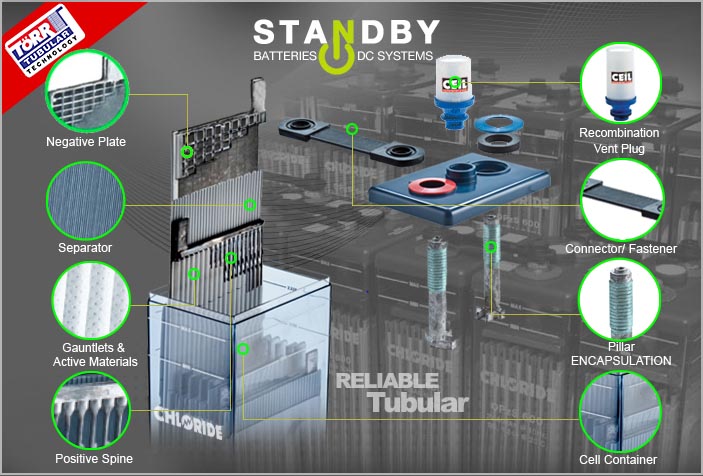TUBULAR BATTERIES
TUBULAR BATTERIES

The INSIDE Story
The Tubular cell was developed in the early 1900s but it was after the World War II that the braided glass fibre gauntlet was developed to house the active material. Though initially meant for cyclic applications, the design is extensively used in most industries such as Power, Telecom, Oil & Gas, Solar etc., due to its proven reliability in float applications.
The Chloride OPzS range has a life span exceeding 15 years (at 25°C).
Chloride has developed the special ToRR tubular technology based on our experience for over half a century.

Negative Plate
The negative plates are cast in antimony grid, and pasted with lead oxide using state of the art MAC (US) pasting machine which ensure uniform density and texture. This helps to enhance the longevity of the battery.

Separator
DARAK-5000 microporous duroplastic separator. It has high temperature stability, mechanical strength, low electrical resistance, high porosity and low acid displacement which makes it very efficient.

Gauntlets & Active Materials
The special non woven gauntlets have a unique structure that enable the electrolyte to penetrate more freely while FURTHER reducing the shedding of the active material. This combination of the gauntlets and the specially formulated active material enhances the cycle life of the battery. The Gauntlets diameter is more than 8 mm thick so that it will give a longer life to the battery and deep discharge features.

Positive Spine
The backbone of the plate. Cast at an incredibly high 100 bar pressure, the special low antimony (1.6%-2.5%) alloy spine is very durable with an extremely low resistance, while having very low maintenance features. This is achieved by using the high technology HADI equipment from Austria. This technology ensures uniform grain orientation and reduced voids for better electrical performance.

Recombination Vent Plug
The cylindrical design recombination element in the plug is filled with catalytic element and absorption deposit. During charging of the battery, oxygen and hydrogen gases will evolve. As these gases pass through the adsorption deposit, the catalytic element within the deposit will get heated up, thus, causes condensation on the inner plastic wall of the Recombination Vent Plug. This droplet of water will then trickle back into the cell, thus, it can help extend the topping up period by at least 5 to 10 years.

Connector / Fastener
The global quality insulted connector protect it from acid attack. The insulation protects operators from electric shocks. Maintains close contact between the terminals for better conductivity, avoiding DC shorts.

Pillar Encapsulation
The pillar is specially constructed using an injection moulded polymer encapsulation around it. The ribbed design of the pillar at the point of the scaling totally eliminate the Crevice Corrosion cause by acid seepage between the rubber gasket and post pillar.

Cell Container
The cell container is made from the Styrene Acrylonitrile (SAN) material, and its transparency allows easy visual inspection.
